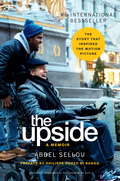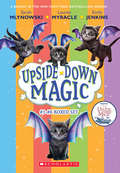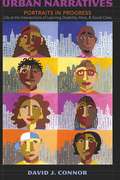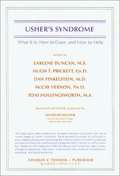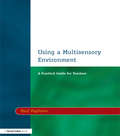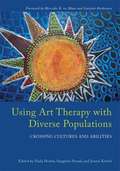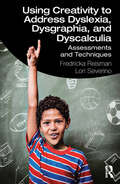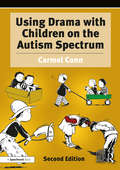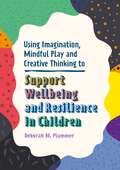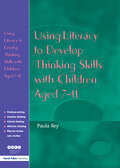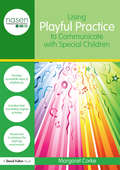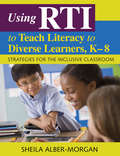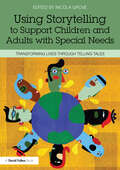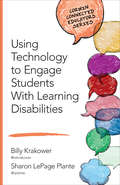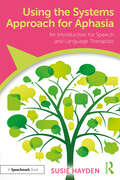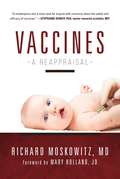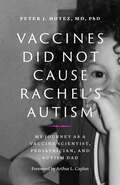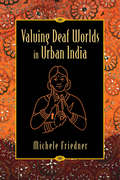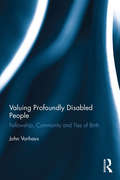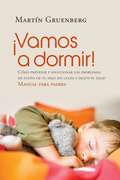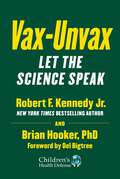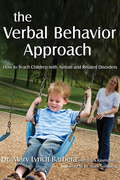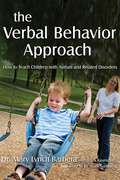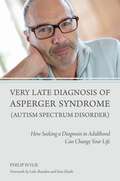- Table View
- List View
The Upside
by Abdel SellouThe story of how Abdel Sellou (a charismatic ex-con) came to be the caretaker of Philippe Pozzo di Borgo (a paralyzed French aristocrat) inspired the award-winning French movie Les Intouchables (2012), which became an international phenomenon and broke records as one of the most successful French movies of all time. Now, The Upside, the American remake of Les Intouchables, starring Kevin Hart, Bryan Cranston, and Nicole Kidman will be released in both the US and the UK in January 2019.Abdel Sellou and Philippe Pozzo di Borgo were two people marginalized by society: Sellou a wisecracking, unemployed immigrant, just out on parole; Pozzo a man born to wealth and privilege, recently paralyzed from the neck down after a paragliding accident. How they came to help each other, and the unlikely friendship that became a lifeline for them both, is an uplifting story that's now been told and retold around the world.
The Upside-Down Magic Collection (Upside-Down Magic)
by Sarah Mlynowski Lauren Myracle Emily JenkinsThe first six books in the New York Times bestselling series -- soon to be a Disney Channel movie!What do you do when you try to turn into a dragon or a kitten, but you accidentally turn into a dritten instead? Or you try to conjure fire but can only make flurries? Or maybe you get to fly, but you can't come back down? For Nory and her friends in Dunwiddle Magic School's Upside-Down Magic class, magic is amazing, unpredictable, and out of control!This collection includes the first six hilarious, upside-down magical adventures! Upside-Down Magic #1: Upside-Down Magic, Upside-Down Magic #2: Showing Off, Upside-Down Magic #3: Sticks & Stones, Upside-Down Magic #4: Dragon Overnight, Upside-Down Magic #5: Weather or Not, and Upside-Down Magic #6: The Big Shrink
Urban Narratives: Portraits in Progress, Life at the Intersections of Learning Disability, Race, and Social Class
by David J. ConnorThis book focuses on the experiences of the author as a teacher in an urban public school special education programs, where students are labeled learning disabled (LD), Black or Latino(a), and working-class or poor.
Usher's Syndrome: What It Is, How to Cope, and How to Help
by Earlene Duncan Hugh T. Prickett Dan Finkelstein Mccay Vernon Toni HollingsworthDescribes what Usher's syndrome is, how it impacts a person's life, and ways to cope with this dual disability.
Using a Multisensory Environment: A Practical Guide for Teachers
by Paul PaglianoThis book provides teachers and therapists with a user-friendly bank of practical ideas and suggestions to use in the MSE for pupils with profound and multiple learning difficulties. These include equipment and resources that can be used to engineer the environment to promote particular outcomes; a set of photocopiable, fast, easy to complete observation and assessment forms; a selection of practical strategies and methods that can be used in the MSE; and ideas to help teachers integrate environment, assessment and instruction to maximize individual programs.
Using Art Therapy With Diverse Populations: Crossing Cultures and Abilities
by Paula Howie Sangeeta Prasad Jennie Kristel Mercedes B. Ter Maat Gaelynn P. Wolf BordonaroArt is a recognised and effective form of therapy that is used all over the world. Yet are the approaches used as universal as the successes? Written with an international focus, this book considers how culture impacts the practice of art therapy in a variety of settings. With contributions from experienced art therapists who have worked in diverse environments, this book attempts to understand and highlight the specific cultural, subcultural and ethnic factors that inform art therapy treatment. It addresses variable factors including setting, population, environment and ability, and how they influence art therapy approaches. It also considers how cultural differences can impact physical art making through choices of color, symbol and metaphor. Each chapter provides a framework showing how art therapy techniques have been used in order to successfully work with distinct populations. This book will provide practitioners with ideas for how to adapt art therapy training and approaches to suit the setting and meet the needs of a huge range of populations. Full of informative case studies, this book will be invaluable reading for art therapists and students of art therapy.
Using Creativity to Address Dyslexia, Dysgraphia, and Dyscalculia: Assessments and Techniques
by Fredricka Reisman Lori SeverinoDesigned to help educators recognize and nurture students with dyslexia, dysgraphia, and dyscalculia, this book guides readers through best practices for using creativity theory and strategies to address the learning challenges for students who have difficulty in acquiring literacy and mathematics content. Offering concrete examples of creativity assessment and pedagogical techniques, chapters are supported by rich appendices providing assessment and screening checklists, time telling objectives, learning trouble spots, a creative approach to teaching place value, and a handy cross-referencing table. Accessible and thorough, this up-to-date guide will help educators develop strategies that acknowledge students’ creative strengths to address learning challenges across the literacy and mathematics curricula.
Using Drama with Children on the Autism Spectrum: A Resource for Practitioners in Education and Health
by Carmel ConnThe second edition of Using Drama with Children on the Autism Spectrum takes the perspective that support for the learning and development of children should have the purpose of giving them the freedom to be more fully who they are and able to function more effectively as themselves in a wider range of contexts. The focus of this new edition is on learning outcomes as expressed by autistic people, for example, to develop better understandings about the social world and to know how to manage everyday situations more successfully. This practical resource book contains more than 150 activities for use with children aged 5–11 years old. Written for mainstream and special education teachers, speech and language therapists, drama teachers, play workers and creative arts therapists, the book shows how using drama with children across the autism spectrum can provide valuable experiences in being with others and communicating with them in enjoyable ways that support the development of well-being and confidence. In addition, drama is presented as a rich medium for reflecting on everyday social situations and developing children’s understandings about the social world. Complete with case studies, photocopiable resources and step-by-step guidance on how to facilitate drama activities that all children can enjoy, this practical resource will be invaluable for those who are looking for new ways of engaging children on the autism spectrum and their peers. The second edition of this practical resource has been extensively revised, updated and re-focused in line with current practice and thinking.
Using Imagination, Mindful Play and Creative Thinking to Support Wellbeing and Resilience in Children (Helping Children to Build Wellbeing and Resilience)
by Deborah PlummerForms part of JKP's 'Helping Children to Improve Wellbeing and Resilience' seriesUsing a model of 'mindfulness play' to help children to achieve wellbeing, this book encourages children to build awareness of their inner and outer worlds. This multidimensional approach, designed and developed by an experienced speech and language therapist, centres on the importance of play activities to build psychological, emotional and social wellbeing and looks into the pivotal role adults play in supporting a child's self-esteem. By promoting the growth of self-esteem in different areas of a child's life, the book shows how adults help children to establish a firm basis of wellbeing from which they can flourish.The accompanying activity booklets that demonstrate the practical application of this approach are:· Helping Children to Manage Transitions· Helping Children to Manage Stress· Helping Children to Manage Friendships· Helping Children to Manage Anger· Helping Children to Build Self-Confidence · Helping Children to Build their Communication SkillsThe strategies in this ebook guide show how imagination, mindfulness and creativity can enhance our daily interactions with children, and the activity books encourage children to build life skills through structured experiences and through experimenting with different ways of thinking and 'being'.
Using Literacy to Develop Thinking Skills with Children Aged 7-11
by Paula IleyThese creative off-the-shelf activities will spark children's thinking skills through speaking, listening, reading and writing. Busy teachers wanting to shake up their lessons will find them indispensable. Includes: problem-solving: creative and critical thinking; emotional thinking; questioning skills and plan-do-review formats clear explanation of underpinning theory advice on differentiating activities links to the National Literacy Strategy Framework.
Using Playful Practice to Communicate with Special Children (nasen spotlight)
by Margaret CorkePlayfulness is important; it creates an alternative space where emotional, cognitive and social dimensions can be explored and tested. This highly practical book explores the endless possibilities of using playful, creative and interactive activities to meaningfully engage with children with multiple learning difficulties or autistic spectrum disorders. The author presents playfulness as ‘an experimental frame of mind’, and encourages practitioners to play with roles, ideas, words, concepts and objects in order to enhance relationships and interventions. By providing accessible steps to playfulness, this text explores some of the contemporary issues surrounding the education of children with severe learning needs, in particular the use of ‘intensive interaction’. This text considers different areas of creative interactive work for practitioners to draw inspiration from, including: Music Interactive Musical Movement Finger Dance Story and Drama Artwork Reflective Circle. The varied array of tried and tested original activities have been devised to encourage the development of social interaction, cognition, play, experimentation and creativity, in particular but not exclusively, for children whose learning needs are more complex. The author also invites teachers working in mainstream, particularly early years and primary education, to investigate the creative possibilities inherent in playfulness and to use the activities in this book to enhance the learning environment. This text offers an abundance of advice, practical strategies and tips for teachers working in special and mainstream early years and primary education. Practitioners such as therapists, care workers, community musicians and creative arts specialists will also find this book useful.
Using RTI to Teach Literacy to Diverse Learners, K-8: Strategies for the Inclusive Classroom
by Sheila Alber-MorganPractical intervention strategies for diverse learners who struggle with literacy! Covering reading and writing, this book shows K–8 teachers how to build the literacy skills of diverse learners in inclusive classrooms. The author discusses instruction and assessment within a Response to Intervention (RTI) framework and how to provide targeted support to students who may require special attention. The book offers: Specific literacy intervention strategies for each tier in a 3-tier RTI framework Examples of assessments and graphic organizers Brief case studies illustrating how the strategies can be used with students A discussion on using thematic units to integrate reading and writing
Using Storytelling to Support Children and Adults with Special Needs: Transforming lives through telling tales
by Nicola GroveThis innovative and wide-ranging book shows how storytelling can open new worlds for learners with or without special educational needs. With sections that outline both therapeutic and educational approaches, the leading practitioners who contribute to this practical resource draw on their extensive experience, and distil their own approaches for the reader to use as inspiration for their own lessons. Providing a highly accessible combination of theory and practice, the contributors to this book: define their own approach to storytelling describe the principles and theory that underpin their practice demonstrate how they work with different types of story provide extensive case-studies and assessment frameworks for a range of different special needs and age ranges provide some ‘top tips’ for practitioners who want to start using stories in this way. Using Storytelling to Support Children and Adults with Special Needs will be of interest to all education professionals as well as therapists, youth workers, counsellors, and storytellers and theatre practitioners working in special education.
Using Technology to Engage Students With Learning Disabilities (Corwin Connected Educators Series)
by William A. Krakower Sharon LePage PlanteLeverage technology to engage students with learning disabilities! Harness the power of today’s technology to improve learning and engagement for students with learning disabilities. By engaging students with learning disabilities using the technology already at your fingertips, you’ll see your students begin to thrive and grow in exciting new ways. In this volume in the Connected Educators Series, you’ll discover: New ideas for using assistive technology to teach core subjects and study skills How to build positive opportunities for students to show what they know Tools to provide better content accessibility How to help students connect and share through technology tools
Using Technology to Engage Students With Learning Disabilities (Corwin Connected Educators Series)
by William A. Krakower Sharon LePage PlanteLeverage technology to engage students with learning disabilities! Harness the power of today’s technology to improve learning and engagement for students with learning disabilities. By engaging students with learning disabilities using the technology already at your fingertips, you’ll see your students begin to thrive and grow in exciting new ways. In this volume in the Connected Educators Series, you’ll discover: New ideas for using assistive technology to teach core subjects and study skills How to build positive opportunities for students to show what they know Tools to provide better content accessibility How to help students connect and share through technology tools
Using the Systems Approach for Aphasia: An Introduction for Speech and Language Therapists
by Susie HaydenUsing the Systems Approach for Aphasia introduces therapists to systems theory, exploring the way in which a holistic method that is already a key part of other health and social care settings can be employed in aphasia therapy. Detailed case studies from the author’s own extensive experience demonstrate how systemic tools can be incorporated into practice, offering practical suggestions for service delivery and caseload management in frequently overloaded community health services. Exploring the treatment process from first encounters, through the management of goals and attainments, to caring for patients after therapy has ended, the book demonstrates a method of delivering therapy in a way that will better serve the people who live with aphasia and their families, as well as the clinician themselves. Key features of this book include: • An accessible overview of systems theory and its use in aphasia therapy. • Consideration of how current popular ideas such as self-management, holistic rehabilitation and compassion focussed therapy can be incorporated to provide the best treatment. • Guidance on when and how to involve families based on case studies. • Case studies throughout to fully illustrate systemic approaches. An essential resource for both students and seasoned clinicians, the theory explored in this book will provide a fresh approach to therapy and new skills for working with people with aphasia and their families.
Vaccines: A Reappraisal
by Richard MoskowitzDrawing on fifty years of experience caring for children and adults, Dr. Moskowitz examines vaccines and our current policy regarding them. Weaving together a tapestry of observed facts, clinical and basic science research, news reports from the media, and actual cases from his own practice, he offers a systematic review of the subject as a whole. He provides scientific evidence for his clinical impression that the vaccination process, by its very nature, imposes substantial risks of disease, injury, and death that have been persistently denied and covered up by manufacturers, the CDC, and the coterie of doctors who speak for it. With the aim of acknowledging these risks, taking them seriously, understanding them more holistically, and ultimately assessing them on a deeper level, he proposes a nationwide debate based on objective scientific research, including what we already know and what still needs to be investigated in the future. He argues that with no serious public health emergency to justify them, requiring vaccines of everyone deprives us all of genuinely informed consent, and prevents parents from making health-care decisions for our children, basic human rights that we still profess to hold dear. For the present, given the legitimate controversy surrounding the mandates, he proposes that most vaccines simply be made optional and that further research into their risks and benefits be conducted by an independent agency in the public interest, untainted by industry funding, CDC sponsorship, and the quasi-religious sanctimony that is widely invoked on their behalf.
Vaccines Did Not Cause Rachel's Autism: My Journey as a Vaccine Scientist, Pediatrician, and Autism Dad
by Peter J. HotezInternationally renowned medical scientist, frequent media contributor, and autism dad Dr. Peter J. Hotez explains why vaccines do not cause autism.In 1994, Peter J. Hotez's nineteen-month-old daughter, Rachel, was diagnosed with autism. Dr. Hotez, a pediatrician-scientist who develops vaccines for neglected tropical diseases affecting the world's poorest people, became troubled by the decades-long rise of the influential anti-vaccine community and its inescapable narrative around childhood vaccines and autism. In Vaccines Did Not Cause Rachel's Autism, Hotez draws on his experiences as a pediatrician, vaccine scientist, and father of an autistic child. Outlining the arguments on both sides of the debate, he examines the science that refutes the concerns of the anti-vaccine movement, debunks current conspiracy theories alleging a cover-up by the Centers for Disease Control and Prevention, and critiques the scientific community's failure to effectively communicate the facts about vaccines and autism to the general public, all while sharing his very personal story of raising a now-adult daughter with autism.A uniquely authoritative account, this important book persuasively provides evidence for the genetic basis of autism and illustrates how the neurodevelopmental pathways of autism are under way before birth. Dr. Hotez reminds readers of the many victories of vaccines over disease while warning about the growing dangers of the anti-vaccine movement, especially in the United States and Europe. Now, with the anti-vaccine movement reenergized in our COVID-19 era, this book is especially timely. Vaccines Did Not Cause Rachel's Autism is a must-read for parent groups, child advocates, teachers, health-care providers, government policymakers, health and science policy experts, and anyone caring for a family member or friend with autism."When Peter Hotez—an erudite, highly trained scientist who is a true hero for his work in saving the world's poor and downtrodden—shares his knowledge and clinical insights along with his parental experience, when his beliefs in the value of what he does are put to the test of a life guiding his own child's challenges, then you must pay attention. You should. This book brings to an end the link between autism and vaccination."—from the foreword by Arthur L. Caplan, NYU School of Medicine
Valuing Deaf Worlds in Urban India
by Michele Ilana FriednerAlthough it is commonly believed that deafness and disability limits a person in a variety of ways, Valuing Deaf Worlds in Urban India describes the two as a source of value in postcolonial India. Michele Friedner argues that the experiences of deaf people offer an important portrayal of contemporary self-making and sociality under new regimes of labor and economy in India. Friedner contends that deafness actually becomes a source of value for deaf Indians as they interact with nongovernmental organizations, with employers in the global information technology sector, and with the state. In contrast to previous political economic moments, deaf Indians increasingly depend less on the state for education and employment, and instead turn to novel and sometimes surprising spaces such as NGOs, multinational corporations, multilevel marketing businesses, and churches that attract deaf congregants. They also gravitate towards each other. Their social practices may be invisible to outsiders because neither the state nor their families have recognized Indian Sign Language as legitimate, but deaf Indians collectively learn sign language, which they use among themselves, and they also learn the importance of working within the structures of their communities to maximize their opportunities. Valuing Deaf Worlds in Urban India analyzes how diverse deaf people become oriented toward each other and disoriented from their families and other kinship networks. More broadly, this book explores how deafness, deaf sociality, and sign language relate to contemporary society.
Valuing Profoundly Disabled People: Fellowship, Community and Ties of Birth (Routledge Research in Special Educational Needs)
by John VorhausGrowing numbers of human beings live with profound and multiple learning difficulties and disabilities. Exploring the moral, social and political implications of this trend, Valuing Profoundly Disabled People addresses questions that are high on policy and practice agendas in numerous regions around the world, including the UK and the EU, the USA, and Australasia. In this important work Vorhaus examines fundamental moral and social questions about profound disability, and each chapter combines a comprehensive review of existing literature with thought-provoking and original philosophical arguments. Vorhaus argues that there is a pressing need to consider the moral and political claims of people whose lives are characterised by extensive impairments, dependency and vulnerability. The book prompts readers to reflect on complex issues relating to the practices of caring, teaching and treating people with profound disabilities in contexts such as education, health care and social policy. Providing a much-needed contribution to the field, this book will be of interest to postgraduates, academics and researchers in a number of distinct and interrelated fields, including disability and impairment, human rights, philosophy, sociology, health and social policy, and education. The book will also be of great interest to practitioners and policymakers seeking to promote the aims of realising human potential and respecting disability.
VAMOS A DORMIR! (EBOOK)
by Martin GruenbergEs necesario dejar llorar a nuestro hijo para que aprenda a dormir? En este libro el doctor Martín Gruenberg, médico pediatra y apasionado investigador de los problemas del sueño infantil, explica que dejar llorar a un niño para enseñarle a dormir es una herramienta que, utilizada de manera inadecuada, puede resultar contraproducente. También nos enseña a reconocer las distintas etapas madurativas por las que puede estar atravesando nuestro hijo y cómo resolver los trastornos de sueño asociados a ellas, respetando sus necesidades afectivas y emocionales. Con ejemplos y sugerencias prácticas ofrece distintas soluciones para otros temas relacionados con el sueño, como el ronquido y la enuresis, y nos sorprende con consejos útiles y aplicables para poner límites claros de acuerdo a la edad de cada niño.
Vax-Unvax: Let the Science Speak (Children’s Health Defense)
by Robert F. Kennedy Jr. Brian HookerThe Studies the CDC Refuses to Do This book is based on over one hundred studies in the peer-reviewed literature that consider vaccinated versus unvaccinated populations. Each study is analyzed, and health differences among infants, children, and adults who have been vaccinated and those who have not are presented and put in context. Readers will find information on: The infant/child vaccination schedule Thimerosal in vaccines Live virus vaccines The human papillomavirus (HPV) vaccine Vaccination and Gulf War illness Influenza (flu) vaccines Hepatitis B vaccination The COVID-19 vaccine Vaccines during pregnancy Given the massive push to vaccinate the entire global population, this book is timely and necessary for individuals to make informed choices for themselves and their families.
The Verbal Behavior Approach: How to Teach Children with Autism and Related Disorders
by Mary Lynch BarberaA step-by-step guide on how to help children develop language and speaking skills.The Verbal Behavior (VB) approach is a form of Applied Behavior Analysis (ABA), that is based on B.F. Skinner's analysis of verbal behavior and works particularly well with children with minimal or no speech abilities. In this book Dr. Mary Lynch Barbera draws on her own experiences as a Board Certified Behavior Analyst and also as a parent of a child with autism to explain VB and how to use it.This step-by-step guide provides an abundance of information about how to help children develop better language and speaking skills, and also explains how to teach non-vocal children to use sign language. An entire chapter focuses on ways to reduce problem behavior, and there is also useful information on teaching toileting and other important self-help skills, that would benefit any child.This book will enable parents and professionals unfamiliar with the principles of ABA and VB to get started immediately using the Verbal Behavior approach to teach children with autism and related disorders.(P)2017 Hodder & Stoughton Limited
The Verbal Behavior Approach: How to Teach Children with Autism and Related Disorders
by Tracy Rasmussen Mary Lynch BarberaThe Verbal Behavior (VB) approach is a form of Applied Behavior Analysis (ABA), that is based on B.F. Skinner's analysis of verbal behavior and works particularly well with children with minimal or no speech abilities. In this book Dr. Mary Lynch Barbera draws on her own experiences as a Board Certified Behavior Analyst and also as a parent of a child with autism to explain VB and how to use it. This step-by-step guide provides an abundance of information about how to help children develop better language and speaking skills, and also explains how to teach non-vocal children to use sign language. An entire chapter focuses on ways to reduce problem behavior, and there is also useful information on teaching toileting and other important self-help skills, that would benefit any child. This book will enable parents and professionals unfamiliar with the principles of ABA and VB to get started immediately using the Verbal Behavior approach to teach children with autism and related disorders.
Very Late Diagnosis of Asperger Syndrome (Autism Spectrum Disorder): How Seeking a Diagnosis in Adulthood Can Change Your Life
by Luke Beardon Philip Wylie Sara HeathAs awareness and understanding of Asperger Syndrome and Autism Spectrum Disorder increases, more adults are identifying themselves as being on the spectrum and seeking formal diagnosis. This book discusses the process, the pros and cons, and the after-effects of receiving an autism diagnosis in adulthood. Outlining the likely stages of the journey to diagnosis, this book looks at what the individual may go through as they become aware of their Asperger characteristics and as they seek pre-assessment and diagnosis, as well as common reactions upon receiving a diagnosis - from depression and anger to relief and self-acceptance. Combining practical guidance with advice from personal experience and interviews and correspondence with specialists in the field, the book discusses if and when to disclose to family, friends and employers, how to seek appropriate support services, and how to use the self-knowledge gained through diagnosis to live well in the future.
